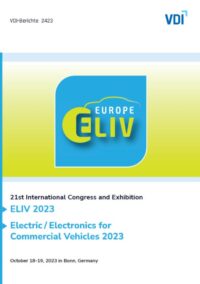ELIV 2023
Electric / Electronics for Commercial Vehicles 2023
Erscheinungsdatum: 18.10.2023
Reihe: VDI-Berichte
Band Nummer: 2423
Ort: Bonn
ISBN: 978-3-18-092423-6
ISSN: 0083-5560
Erscheinungsjahr: 2023
Anzahl Seiten: 738
Produktart: PDF-Datei
Produktbeschreibung
Content
Automated Driving – Systems
Criticality driven data acquisition in autonomous driving – A basis for completeness and safety argumentation 1
Vehicle-to-vehicle (V2V) communication as enabler for improved automated driving functions 17
Electronics Technology
Estimation of Gender and Age of Vehicle Occupants Using Deep Learning 27
QuietComfort Road Noise Control – Helping Carmakers Design Better Cars 39
New Opportunities with Software Defined Lighting – Appearance drives Emotionalization 61
E Vehicle Mobility – System
A Holistic Approach for Designing a Battery Electric Vehicle Thermal Management System 77
Safe and efficient regenerative braking strategies for BEV heavy vehicle combinations 91
A Cloud-based Self-Learning Digital Twin Solution for Increasingly Accurate Range Prediction in Battery Electric Vehicles 103
Automated Driving – Sensors
Using Radar and Vision Fusion for Improved Low-light Pedestrian Detection 113
Automotive Radar Technology Innovations power next-gen ADAS and Autonomous Driving 133
Combining ADAS and SD Maps for Augmented Reality Guidance 135
Development and Testing Autonomous Vehicles (AV) at Scale 149
Vehicle Architecture – Strategy
Plug & Play High-Performance Computer (HPC) and Fluid Cooling Solution 159
Strategically Migrating, Mapping and Scaling Software to new SoC, domain and zone architectures and HPC 169
Towards the next step in vehicle E/E architectures 185
Mastering the software update complexity of modern vehicles 199
E Vehicle Mobility – Components
How to Improve EV Battery Cell Quality – Making Test a Competitive Advantage 211
Analysis of WBG based hybrid semiconductors approach for bidirectional PFC in On-board charger applications 223
Power electronic system technology for future high-power charging systems on highways or large inner-city electric charging stations with several MVA system size 235
Multi-level GaN inverter for highest HV EV performance and efficiency – comparison of 2-level and 3-level inverter topology 247
Software
Snapdragon Ride Flex SoC: The central compute solution that’s bringing the SDV vision to reality 253
Maintaining Open-Source based Software 267
Automotive AI – Innovations
How to Become a Leader by Development of AI – ChatGPT Research Papers Analysed 281
Seeing with Sound: AI-Based Detection of Participants in Automotive Environment from Passive Audio 293
Vehicle Architecture – Aspects
Continuous System Architecture Development for Automated Driving Features 307
New EE Architecture – MB.OS 1.0, the digitalization of the E/E architecture of Mercedes-Benz 321
Connectivity
Achieving Ubiquitous Connectivity for Future Vehicles 331
Cooperative Perception Services to Improve the Safety of Road Users 347
A Holistic Approach for a Universal Vehicle-to-Robot (V2R) Communication Interface 365
Software
A unified middleware for SoC-agnostic application development 379
Automotive OS reloaded – Refocus and Reality Check 385
Automotive AI – Applications
AI-Based Energy Management of Next Generation Architectures 391
Generative Artificial Intelligence – How AI Models Change the Way We Develop Automotive Products 405
Validation and Interpretation of Neural Networks: DNN-Based Object Detection as an Example 419
System Engineering and Processes
Virtual Homologation – new opportunities for the automotive industry to enable more efficient development processes and improving safety and quality of vehicles for high scaling software updates 437
An Approach to Digital Lifecycle Management as a Service 443
Master Algorithm for Event-based Co-Simulation with FMI 3.0 for Timing Accurate Software-in-the Loop 447
Security – Vulnerabilities
Automotive Software Vulnerabilities: Strategies for Early Detection, Mitigation, and Prevention in the Software-Development-Lifecycle 463
Supply chain security risks of software driven products 479
Tales from a Penetration Testing Team 497
Panel Discussion
A leap in innovation – What European OEMs can learn from Chinese OEMs in terms of User Experience 503
Software – Cloud & Data
Sustainable Software Development for Cloud-Native Vehicles 519
Rust for Automotive – A Modern, Memory-Safe and Secure Programming Language 533
Software-Defined Vehicle: Combining Real-Time Safety Critical Functions with Cloud Connectivity 543
System Engineering and Processes
Challenges in the Synchronous Development of Software, Hardware and Mechanics for Drive Systems 559
A Review of using Artificial Intelligence in Large Projects for Requirements Classification 573
Addressing the challenge of “integrating everything” 589
Security – Challenges
Why Trusted Execution Environments are Critical for Automotive Security 599
Distributed development along the automotive supply chain: 8 insightful recommendations for OEMs and suppliers to jointly implement cybersecurity 613
Where is Everybody? – Looking for Remote Attacks on Cars in the Wild 623
Electronics for Commercial Vehicles 2023
SAE J1939 in AUTOSAR – CAN FD and CAN XL – Achieve Higher Data Rates for J1939 Communication in AUTOSAR 635
Event-Chain-Focused Development of System Architectures Makes Complex Systems Manageable 645
How Data-driven Approaches Enhance Agile and Quality-assured Software Development for AD 663
An evolutionary approach to commercializing autonomous vehicles 673
Key Factors of a robust and safe Automated Driving Function – Transferable Insights of City-Bus Platooning in Munich 677
Hydrogen – A Game Changer in the Automotive Industry … and Beyond 689
Electrified commercial vehicle trailers – how to turn a conventional trailer into a hybrid vehicle 703
Modular High Power DC/DC Platform for FC-Applications 711
Keywords: Autonomes Fahren, Straßenlärmkontrolle, effizientes regeneratives Bremsen, Sicherheits Optimierung, Kommunikations Schnittstelle, DNN-basierte Objekt Erkennung, künstliche Intellingenz, KI, hybrides Fahrzeug, autonomous driving, road noise control, efficient regenerative breaking, safety improvement, communication interface, DNN-based object detection, artificial intellingence, AI, hybrid vehicle
* Der VDI-Mitgliedsrabatt gilt nur für Privatpersonen
